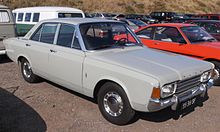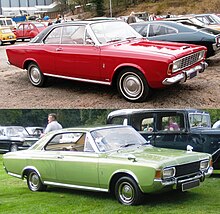| Ford 17M 1967–1971 Ford 20M 1967–1971 Ford 26M 1969–1971 | |
|---|---|
 Ford 17M 2 door saloon (P7b) | |
| Overview | |
| Manufacturer | Ford Germany |
| Also called | Ford Taunus P7a (1967–1968) Ford Taunus P7b (1968–1971) |
| Production | 1967–1971 |
| Assembly | Cologne-Niehl, Germany Genk, Belgium Ulsan, South Korea (Hyundai)[1] |
| Body and chassis | |
| Class | Executive car (E) |
| Body style | 2-door or 4-door saloon 3-door or 5-door "Turnier" estate car 2-door coupé 2-door coach-built (Karl Deutsch) cabriolet [2] |
| Powertrain | |
| Engine | |
| Transmission | 4-speed all-synchromesh manual with column-mounted shifter floor-mounted lever sometimes included or optional automatic transmission (26M, optional at extra cost on some others) |
| Dimensions | |
| Wheelbase | 2,705 mm (106.5 in) |
| Length |
|
| Width | 1,756 mm (69.1 in) |
| Height | 1,464–1,478 mm (57.6–58.2 in) |
| Curb weight | 1,050–1,230 kg (2,315–2,712 lb) |
| Chronology | |
| Predecessor | Ford Taunus 17M P5 |
| Successor | Ford Granada |



The Ford P7 is a range of large family saloons produced by Ford Germany between autumn 1967 and December 1971. The P7 was marketed as the Ford 17M, Ford 20M and Ford 26M.
At launch, the 17M was available with four different engine sizes, ranging from 1.5 to 2.3 litres. The more lavishly appointed 20M was also offered, but only with the larger two engines. The range was subsequently broadened further, and from 1969, the 26M joined the range, featuring the same body, but a larger engine, automatic transmission as standard, and various other luxury features.[2]
The Taunus 17M name had been applied to a succession of family saloons from Ford Germany since 1957, but the introduction of the 1967 car coincided with the removal of the "Taunus" name. Nevertheless, for the avoidance of confusion, the 17M and 20M models introduced in 1967, as well as the 26M introduced in 1969, are usually identified, in retrospect, as the Ford P7. It was the seventh newly designed German Ford to be launched after the Second World War, so it was from inception known within the company as Ford Project 7 (P7) or more simply as the Ford P7.
During the months following its introduction, sales were disappointing and the company rushed to produce an extensively face-lifted model. This appeared, with various styling changes and a modified range of engine options, in August 1968, less than a year after the P7's introduction. To differentiate between the model produced before August 1968, and that produced between August 1968 and the end of 1971, the former is normally designated as the Ford P7a and the latter as the Ford P7b.[2] The P7a had slightly different bodywork up front for the four-cylinder (17M) and six-cylinder (20M) models, with a 72 mm (2.8 in) longer front overhang.[3] The P7b did away with this barely noticeable distinction.
Between September 1967 and August 1968, 155,780 P7a models were produced. Between August 1968 and December 1971, 567,482 P7b models were produced.[2]
- ^ "Ford 20M". Hyundai. Retrieved April 9, 2022.
- ^ a b c d Zink, Günther (2009). Oldtimer Katalog. Königswinter: HEEL Verlag GmbH. p. 151. ISBN 978-3-86852-067-5.
- ^ d'Angelo, Sergio, ed. (1968). World Cars 1968. Bronxville, NY: L'Editrice dell'Automobile LEA/Herald Books. pp. 177–180.
